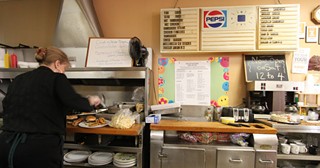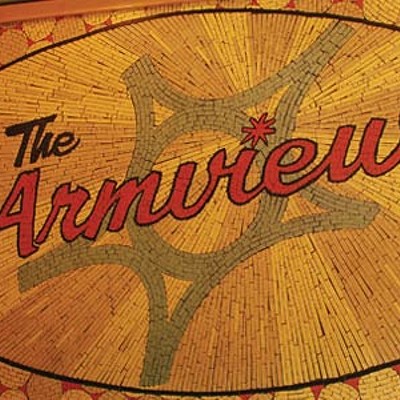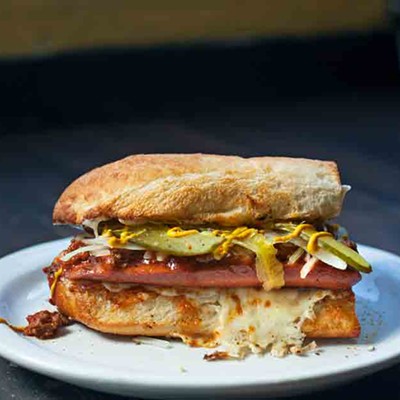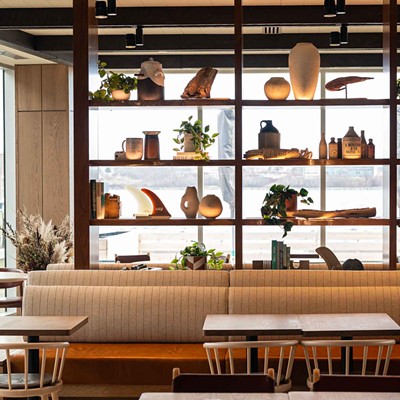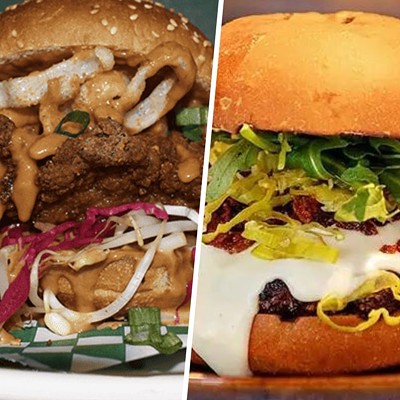The past 20 years have possibly been the most exciting, progressive two decades that the city has seen---food-wise, at least. While various special interest groups argue about what's progress and what's not, and development is bogged in municipal government mire, restaurant culture has seen significant changes.
In 1993, Mosaic (the web browser that would popularize surfing) had just been released and the internet was in its infancy. If you wanted to see a menu, you looked in the Yellow Pages or stood outside the door.
The Yellow Pages of '93 revealed plenty of high-end dining options, a surfeit of choice in the budget-priced family and diner end, but not a whole lot in the middle.
Fat Frank's Snaffles on Duke Street was lauded as "One of the most elegant restaurants in North America...and one of the best" by celebrated New York Times food critic Craig Claibourne. Ferara's Ristorante on Quinpool, daMaurizio & Bacchus Wine Bar in the Brewery Market and Granville Street's Silver Spoon were all considered special occasion restaurants. Across the harbour, MacAskill's was the place to go. A romantic evening meant Cafe Chianti; business deals called for Ryan Duffy's Steakhouse on Spring Garden, where your Caesar salad was made table-side with great ceremony. Over the years, some fine dining came and went: Maple was the first "celebrity chef"-fueled room when Michael Smith ran the kitchen, Bish brought true elegance to waterfront dining (and later became The Bicycle Thief). Today there is still plenty of fancy feasting: CUT, Onyx, Fiasco and the Press Gang, for starters. Dining rooms like the Five Fishermen and McKelvies, once typically reserved for tourists, are still around, appreciated by locals for service and consistency.
But the real foundations of dining out in what is now the HRM has always been the family style, family owned restaurants, the ones whose lifespans see several generations of customers, the ones who have been around for 30, 40 or 50 years. These include Dartmouth's Palladium, Halifax's Bluenose II, Athens and Cousins. These are the places where the daily specials mean a regular menu item plus soup, and rice pudding or JELL-O, the places that are packed on Sundays after mass, and at 5pm for supper.
Sharing room at this end of the restaurant spectrum have been the diners, the lunch counters where the working folk take their meals. John's Lunch, the Westcliff and the Esquire are largely unchanged; the South End Diner and Commons Grill have been relegated to memory, while the Armview is enjoying a new life after a major overhaul.
In a class of their own are two taverns. The legendary Mic Mac Tavern (now Mic Mac Bar & Grill) is still going strong even after allowing women to enter in the mid-'70s. Now known more for its ribs and steaks, the Mic Mac is a perpetually crowded eatery where men serve the beer and women serve the food, and nobody seems to mind waiting in line for a seat to open up. And then there's downtown Halifax's Midtown Tavern and its steak and eggs---sadly uprooted but fondly remembered for its original digs, littered with sports and news guys.
In 1993, the only type of restaurant that seemed in short supply was the mid-priced restaurant, when you wanted to go out for dinner someplace a little more refined than family style, but not too over-the-top.
Thackeray's, Soho Kitchen and Hogie's were long-time popular choices; the late night crowd enjoyed La Cave on Blowers.
Twenty years later, we are seeing far more variety in the "middle class" of restaurants; nice places to eat that don't break the bank or require dress up. Recent past and present luminaries in this class include Fid, the Cellar Bar & Grill, il Mercato Trattoria, Saege, the Birmingham, Le Bistro by Liz (the classic Le Bistro reborn), Brussels and ela!.
If your 1993 appetite veered toward the exotic, your choices weren't too bad---Halifax is the birthplace of the modern donair, after all, the roots of which are based in the Middle Eastern doner kebab. Asian options abounded: Canadian Chinese stalwarts like Dartmouth's East West and Garden View, the Great Wall, and King Wah were thriving. Authentic Cantonese could be had at Qi Lin in the Brewery Market. Japanese Suisha Garden in the Maritime Mall had morphed into Niji, about a decade before the sushi tsunami hit the city. Splendid Indian food was featured at the Chicken Tandoor, Curry Village, the Guru, and Samosa Plus. King Spring Roll on Barrington and the Thu-do in Bedford did Vietnamese. Upscale Greek could be found way down Barrington at Old Man Moriah's, and Alderney Drive's Blue Cactus was a Mexican joint. Mario's La Scala and the Daily Catch brought tastes of Italy. And over at the Halliburton House Inn, wild game was (and is) the order of the day.
For a relatively staid, politically short-sighted city, Halifax is remarkably cosmopolitan in its food culture. The world has been offered to us on plates, and we have embraced much of it. Some cuisines have settled in (Lebanese, Greek, Italian, Chinese, Indian, Thai) while some have had relatively fleeting stays (Spanish at La Paloma, the Hungry Hungarian, the Ethiopian).
Sometime in the mid-'90s, hotel restaurants started to shake the stigma of being just guest conveniences. Ray Bear turned Gio at the Prince George into a destination restaurant; Luis Clavel at Seasons by Atlantica, and Erwin Palo at the Holiday Inn Harbourview experiment with molecular gastronomy, and have helped dispel the myth of generic hotel food.
Regulations around restaurants have changed, too. Remember when you could light up after a meal? While most restaurants did have designated non-smoking areas, Pitchman's Pub and Stayner's Wharf tried to go completely smoke-free in 2002, and failed---just a little too ahead of their time. In December of 2006, Nova Scotia banned smoking in public places. There was uproar from bar owners and fears of lost business and forced closures but as it turns out, most people came out to restaurants to eat and drink, and continued to do so.
Nova Scotia's antiquated liquor laws finally began to loosen around 2003 with the approval of private wine stores (Bishop's Cellar, Premier Wines and Spirits), although they operate under draconian restrictions as to what can be imported and sold. The Nova Scotia Liquor Comission continues to have a stranglehold on consumers, although the resulting brew-ha-ha over its ill-advised persecution of wine kit stores caused it to unclench its bony claw just a little.
In 1993, commercial breweries and the Granite Brewery brew pub were beer options; the proliferation of brew pubs and craft breweries like Garrison and Propeller and baby Bridge Brewing has expanded suds selection considerably.
But it's the wine industry that's seen the greatest growth. With a dozen vineyards producing high-quality award-winning vintages, Nova Scotian wine is no longer a punch line. In 2012, the first wine appellation for Nova Scotia was launched with Tidal Bay. (Appellation refers to the region where the grapes were grown.) Each winery produces its own version of the white, but Tidal Bay wines all follow the same set of standards and use 100 percent Nova Scotia grown grapes.
Milano's, a little Italian place on the corner of Chebucto and Oxford, became the city's first bring-your-own-wine restaurant in 2004, circumventing liquor law by having diners purchase a "membership" and operating as a private club. Three years later, provincial law permitted restaurants to implement a BYOW program. Many HRM restaurants offer the option, but whether it's from high corkage fees, little interest or other factors, the idea hasn't taken off here.
The Halifax Food & Wine Club was launched in 2005 by Mark DeWolfe and Sean Buckland, likable guys who put a fresh, approachable face on wine appreciation. In 2007, I interviewed Scott London, the city's only working sommelier; now there are more certified sommeliers than there are restaurants to employ them. High-end wine bars (Seven Wine Bar, Mosaic), enjoyed great success for a spell, but it's the more intimate, low-key spots like Obladee that are currently thriving.
The greatest impact on the food scene in the past 20 years has been computer technology. The great thing about social media is that it enables restaurants and diners to interact on an intense and immediate level. Social media is a powerful advertising tool, and word of mouth spreads like soft butter on warm bread. Restaurants and chefs can tweet pictures of their specials and engage guests on Facebook. But that in turn becomes a drawback, because one unhappy customer can reach that many more people through sites such as TripAdvisor and Yelp. With little accountability, review posters can hide behind the anonymity of a nickname and say largely what they like, unfettered.
Anyone can become a "critic," and restaurants have to learn to manage and protect their internet presence and reputations. There might be some old-school establishments that can afford to refuse partaking in the digital age, but those are dwindling. The best offense, they say, is a good offense, and by maintaining strong online ties to guests, and keeping a watchful eye out, restaurants can work quickly to resolve potential issues and maintain some control over e-reputation.
Food trends over the past two decades included the all-you-can-eat Chinese buffet, at its peak in '93 with the Oriental Pearl Buffet and its ilk as far-flung as Woodlawn and Spryfield; for the most part, they have mercifully vanished.
Around the same time, sushi restaurants were popping up all over and after the dust settled, several high-quality places surfaced to stay: Doraku (now Suzuki), Dharma, Sushi Nami Royale just a trio of those.
Later, the trend of neighbourhood restaurants led by community-minded Chris Smith at Jamieson's, and Jane Wright at jane's on the common took hold; this trend spreads with suburban sprawl, affording diners the opportunity to walk to eateries close to home.
Currently the "gourmet" burger battles are being waged: started by Cheese Curds, joined by rivals like Ace Burger Company and flipburger.
Globally, street food is enjoying attention from food and travel network programs, and just beginning to make headway here. In 1993, HRM street food was either a chip truck (shoutout to Bud the Spud!), or a hot dog cart outside the Misty Moon. Now, delightfully worldly meals can be had at Nomad Gourmet and the Food Wolf. The food truck culture is somewhat hampered with red tape regulations tangled in the truck axles, it remains to be seen if that proves too discouraging.
But, the biggest trend in the past 20 years has to be the shifting back to local. In 2007, the ignition of a smoldering interest in farm-to-fork eating, locally sourced food led to the widespread locavore movement. Trailblazers included Dennis Johnston of Fid, Scott Vail of Stories, Craig Flinn of Chives and Michael Howell of Wolfville's Tempest. It hasn't been that many generations since everyone ate this way; now factors such as environmental concerns and food safety issues have us seeking sustenance close to home. We want to know where our food is from and what's in it. Fifty-mile dining has gone from trend to movement to way of life. With the local movement here to stay, neighborhood restaurants will continue to thrive, and interest in culinary arts like curing meats, canning and preserving, will surge.
And what do we have to look forward to?
Halifax's north end is enjoying a culinary renaissance, led by three: Jessi Gillis, Frédéric Tandy and Jenna Mooers. Gillis' butcher shop, the Highland Drive Storehouse, offers custom cuts of local meats, local produce and niche products like bone marrow butter and pickled fiddleheads. Tandy operates Ratinaud French Cuisine, a charcuterie shop offering specialty cheeses, cured meats and classic French foods. And Mooers just opened neighbourhood restaurant EDNA on Gottingen. The daughter of Jane Wright, she shares her mother's drive to provide an uncommonly good dining experience, but her vision her own.
Let's raise a glass in celebration of the last 20, and pull up our chairs to the table for the next 20.

